remote control Alfa Romeo 166 2008 Owner handbook (in English)
[x] Cancel search | Manufacturer: ALFA ROMEO, Model Year: 2008, Model line: 166, Model: Alfa Romeo 166 2008Pages: 272, PDF Size: 4.17 MB
Page 156 of 272
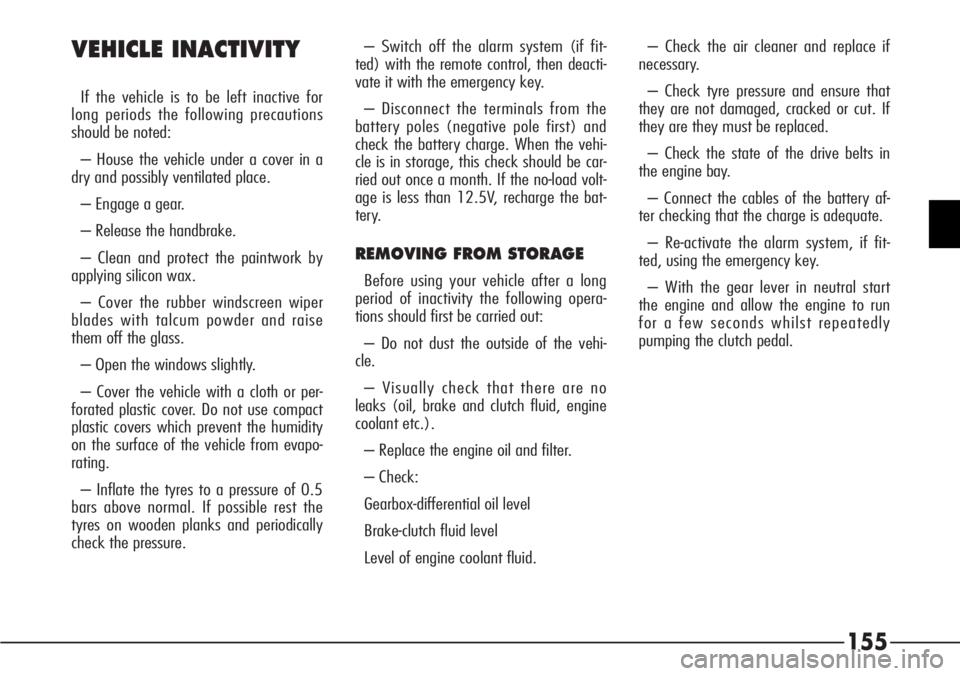
155 VEHICLE INACTIVITY
If the vehicle is to be left inactive for
long periods the following precautions
should be noted:
– House the vehicle under a cover in a
dry and possibly ventilated place.
– Engage a gear.
– Release the handbrake.
– Clean and protect the paintwork by
applying silicon wax.
– Cover the rubber windscreen wiper
blades with talcum powder and raise
them off the glass.
– Open the windows slightly.
– Cover the vehicle with a cloth or per-
forated plastic cover. Do not use compact
plastic covers which prevent the humidity
on the surface of the vehicle from evapo-
rating.
– Inflate the tyres to a pressure of 0.5
bars above normal. If possible rest the
tyres on wooden planks and periodically
check the pressure.– Switch off the alarm system (if fit-
ted) with the remote control, then deacti-
vate it with the emergency key.
– Disconnect the terminals from the
battery poles (negative pole first) and
check the battery charge. When the vehi-
cle is in storage, this check should be car-
ried out once a month. If the no-load volt-
age is less than 12.5V, recharge the bat-
tery.
REMOVING FROM STORAGE
Before using your vehicle after a long
period of inactivity the following opera-
tions should first be carried out:
– Do not dust the outside of the vehi-
cle.
– Visually check that there are no
leaks (oil, brake and clutch fluid, engine
coolant etc.).
– Replace the engine oil and filter.
– Check:
Gearbox-differential oil level
Brake-clutch fluid level
Level of engine coolant fluid.– Check the air cleaner and replace if
necessary.
– Check tyre pressure and ensure that
they are not damaged, cracked or cut. If
they are they must be replaced.
– Check the state of the drive belts in
the engine bay.
– Connect the cables of the battery af-
ter checking that the charge is adequate.
– Re-activate the alarm system, if fit-
ted, using the emergency key.
– With the gear lever in neutral start
the engine and allow the engine to run
for a few seconds whilst repeatedly
pumping the clutch pedal.
Page 191 of 272
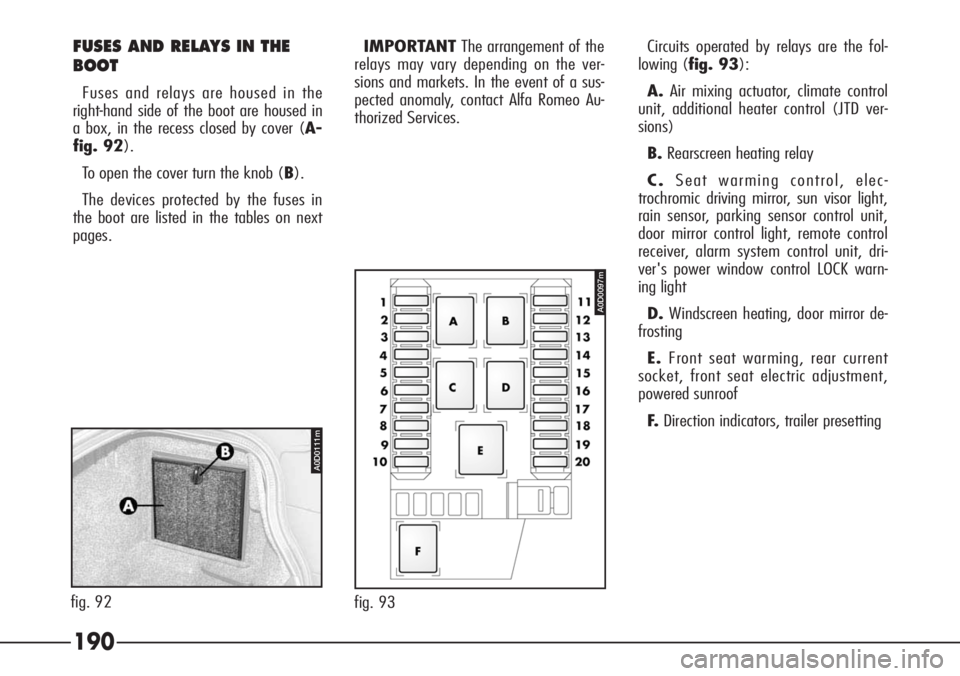
190
FUSES AND RELAYS IN THE
BOOT
Fuses and relays are housed in the
right-hand side of the boot are housed in
a box, in the recess closed by cover (A-
fig. 92).
To open the cover turn the knob (B).
The devices protected by the fuses in
the boot are listed in the tables on next
pages.IMPORTANTThe arrangement of the
relays may vary depending on the ver-
sions and markets. In the event of a sus-
pected anomaly, contact Alfa Romeo Au-
thorized Services.Circuits operated by relays are the fol-
lowing (fig. 93):
A.Air mixing actuator, climate control
unit, additional heater control (JTD ver-
sions)
B.Rearscreen heating relay
C.Seat warming control, elec-
trochromic driving mirror, sun visor light,
rain sensor, parking sensor control unit,
door mirror control light, remote control
receiver, alarm system control unit, dri-
ver's power window control LOCK warn-
ing light
D.Windscreen heating, door mirror de-
frosting
E.Front seat warming, rear current
socket, front seat electric adjustment,
powered sunroof
F.Direction indicators, trailer presetting
518PGS
fig. 93
A0D0097m
A0D0111m
fig. 92
Page 194 of 272

193
System/Component Fuse no. Ampere Location
Rearscreen heating 1 30A fig. 93
Relay coil T21, T22, T23 (boot box) 3 5A fig. 86
Relay coil T24 (boot box) 5 10A fig. 86
Remote control receiver 15 10A fig. 93
Sound amplifier 20 25A fig. 93
Sound system 4 15A fig. 86
Sound system controls on steering wheel 5 10Afig. 86
Starter motor 1 30A fig. 89
Trailer presetting 12 10A fig. 93
Windscreen heating 7 15A fig. 93
Windscreen wiper 14 25A fig. 86
System/Component Fuse no. Ampere Location
Navigator 18 5A fig. 86
Parking sensors (control unit) 15 10A fig. 93
Power windows (driver's control
LOCK warning light) 15 10A fig. 93
Powered sunroof 10 20A fig. 93
Presetting 4 – fig. 93
11 – fig. 93
Rain sensor 15 10A fig. 93
Rear current socket 16 20A fig. 93
Rear LH power window (ABI control unit) 14 20Afig. 93
Rear RH power window (ABI control unit) 17 20Afig. 93
Page 208 of 272
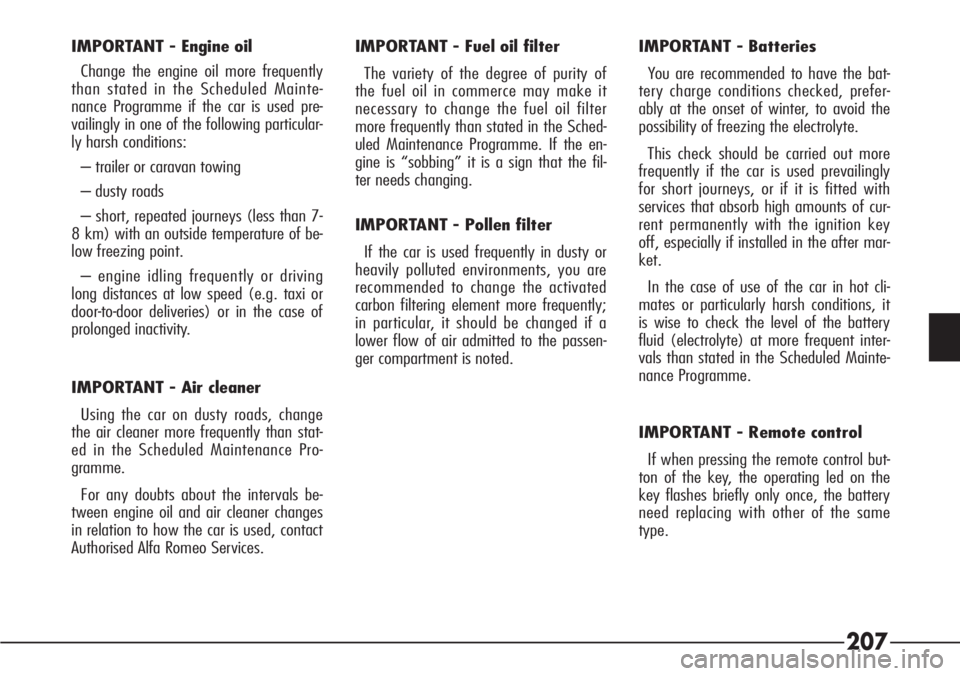
207
IMPORTANT - Engine oil
Change the engine oil more frequently
than stated in the Scheduled Mainte-
nance Programme if the car is used pre-
vailingly in one of the following particular-
ly harsh conditions:
– trailer or caravan towing
– dusty roads
– short, repeated journeys (less than 7-
8 km) with an outside temperature of be-
low freezing point.
– engine idling frequently or driving
long distances at low speed (e.g. taxi or
door-to-door deliveries) or in the case of
prolonged inactivity.
IMPORTANT - Air cleaner
Using the car on dusty roads, change
the air cleaner more frequently than stat-
ed in the Scheduled Maintenance Pro-
gramme.
For any doubts about the intervals be-
tween engine oil and air cleaner changes
in relation to how the car is used, contact
Authorised Alfa Romeo Services.IMPORTANT - Fuel oil filter
The variety of the degree of purity of
the fuel oil in commerce may make it
necessary to change the fuel oil filter
more frequently than stated in the Sched-
uled Maintenance Programme. If the en-
gine is “sobbing” it is a sign that the fil-
ter needs changing.
IMPORTANT - Pollen filter
If the car is used frequently in dusty or
heavily polluted environments, you are
recommended to change the activated
carbon filtering element more frequently;
in particular, it should be changed if a
lower flow of air admitted to the passen-
ger compartment is noted.IMPORTANT - Batteries
You are recommended to have the bat-
tery charge conditions checked, prefer-
ably at the onset of winter, to avoid the
possibility of freezing the electrolyte.
This check should be carried out more
frequently if the car is used prevailingly
for short journeys, or if it is fitted with
services that absorb high amounts of cur-
rent permanently with the ignition key
off, especially if installed in the after mar-
ket.
In the case of use of the car in hot cli-
mates or particularly harsh conditions, it
is wise to check the level of the battery
fluid (electrolyte) at more frequent inter-
vals than stated in the Scheduled Mainte-
nance Programme.
IMPORTANT - Remote control
If when pressing the remote control but-
ton of the key, the operating led on the
key flashes briefly only once, the battery
need replacing with other of the same
type.
Page 222 of 272

221
CHARGING THE BATTERY
IMPORTANT The description of the
battery charging procedure is described
only for informative purposes. This opera-
tion should be carried out by Authorized
Alfa Romeo Services.
Charging should be slow at a low amp
rating for about 24 hours. Charging for a
longer time may damage the battery.
Charge the battery as follows:
– If the car is fitted with an alarm sys-
tem, turn off the alarm with the remote
control and deactivate the system turning
the emergency key to “OFF” (see “Elec-
tronic alarm” in the chapter “Getting to
know your car”).– Disconnect the terminals of the elec-
tric system from the battery poles.
– Connect the charger cables to the bat-
tery.
– Turn on the charger.
– After charging turn off the charger be-
fore disconnecting it from the battery.
– Re-connect the terminals to the bat-
tery poles correctly.
– Turn the ignition key to MARand
leave it in this position for 30 seconds to
1 minute, then turn to STOPfor about 5
to 10 seconds, after which the engine
can be started.
– Remember to reactivate the alarm
system (if present) turning the emer-
gency switch to “ON”.
The wrong electric and
electronic accessory in-
stallation may cause se-
vere vehicle damages.When doing any work on
the battery or near it, al-
ways wear special protective gog-
gles.
Working with the fluid
level too low damages
the battery irreparably, even
breaking the body and completely
leaking the acid contained.
WARNING
WARNING
Page 232 of 272
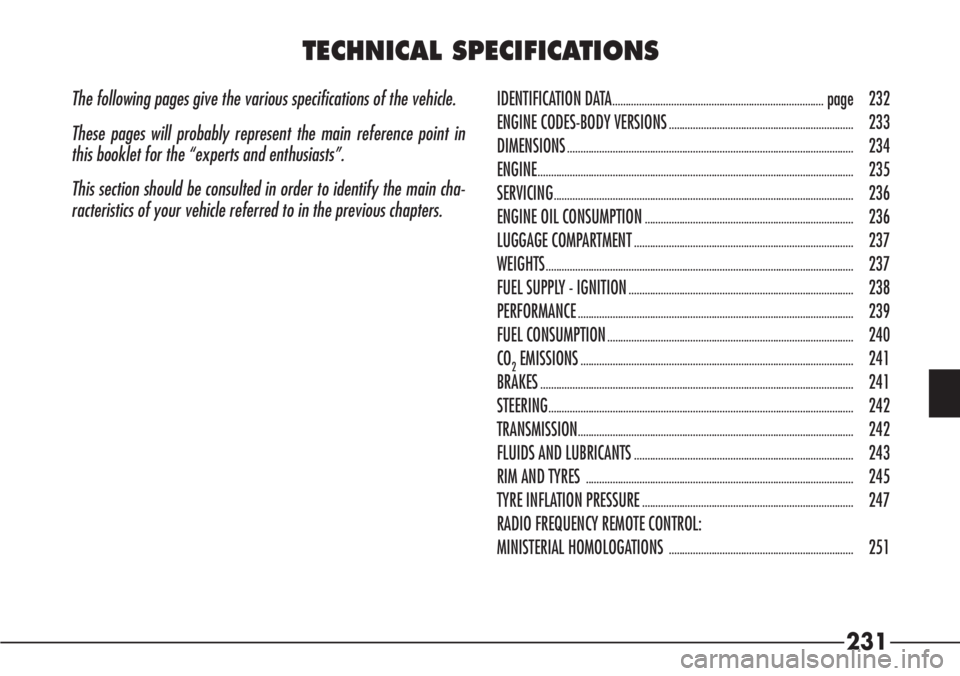
231
The following pages give the various specifications of the vehicle.
These pages will probably represent the main reference point in
this booklet for the “experts and enthusiasts”.
This section should be consulted in order to identify the main cha-
racteristics of your vehicle referred to in the previous chapters.IDENTIFICATION DATA...............................................................................page 232
ENGINE CODES-BODY VERSIONS
.....................................................................233
DIMENSIONS
...........................................................................................................234
ENGINE
......................................................................................................................235
SERVICING
................................................................................................................236
ENGINE OIL CONSUMPTION
..............................................................................236
LUGGAGE COMPARTMENT
..................................................................................237
WEIGHTS
...................................................................................................................237
FUEL SUPPLY - IGNITION
....................................................................................238
PERFORMANCE
.......................................................................................................239
FUEL CONSUMPTION
............................................................................................240
CO
2EMISSIONS......................................................................................................241
BRAKES
.....................................................................................................................241
STEERING
..................................................................................................................242
TRANSMISSION
.......................................................................................................242
FLUIDS AND LUBRICANTS
..................................................................................243
RIM AND TYRES
....................................................................................................245
TYRE INFLATION PRESSURE
...............................................................................247
RADIO FREQUENCY REMOTE CONTROL:
MINISTERIAL HOMOLOGATIONS
.....................................................................251
TECHNICAL SPECIFICATIONS
Page 251 of 272
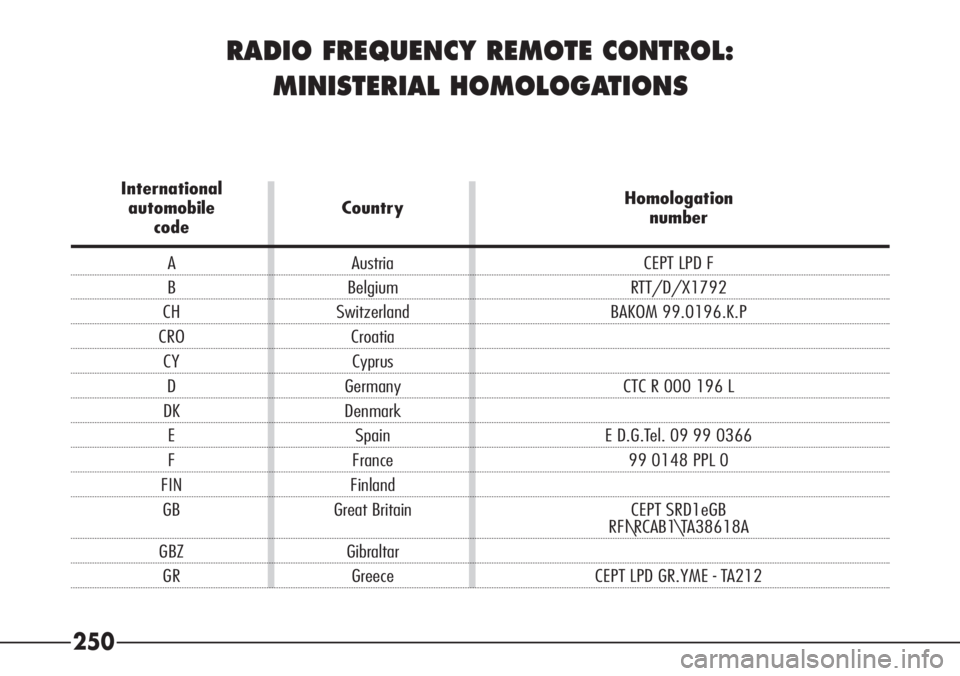
250
RADIO FREQUENCY REMOTE CONTROL:
MINISTERIAL HOMOLOGATIONS
International
Homologation
automobile Country
number
code
A Austria CEPT LPD F
B Belgium RTT/D/X1792
CH Switzerland BAKOM 99.0196.K.P
CRO Croatia
CY Cyprus
D Germany CTC R 000 196 L
DK Denmark
E Spain E D.G.Tel. 09 99 0366
F France 99 0148 PPL 0
FIN Finland
GB Great Britain CEPT SRD1eGB
RFI\RCAB1\TA38618A
GBZ Gibraltar
GR Greece CEPT LPD GR.YME - TA212
Page 266 of 272

265
Radio ........................................122
Radio-frequency remote control ........251
Radio transmitters and cellular
telephones ..............................156
Rain sensor ....................................61
Rear fog guards ..............................94
Rear roof lamps ............................101
Rear seat ........................................35
Rearscreen heating ..........................86
Refuelling......................................236
Relay (replacement) ......................186
Reversing lights..............................178
RPM counter....................................71
Safeguarding the emission
control devices ..........................150
Safeguarding the environment ........129
Safety belts ....................................40
Ski compartment ............................35
Snow chains..................................147Spark plugs ..................................224
Starting device ............................26-27
Stationary vehicle ..........................138
Steering........................................242
Steering column stalks ......................57
Steering lock ..................................27
Steering wheel (adjustment lever) ......36
STR system (Sport Throttle Response) 63
Sun visors ....................................100
Sunroof ........................................103
Supply/ignition ............................238
Technical specifications..........231
Telephone (provision) ....................102
Third stop light (bulb change) ..........180
Top speeds ....................................239
Tow hook ..............................153-154
Towing the car or another vehicle......196
Towing trailers ..............................152
Transmission ................................242Travelling ......................................137
Tyres
- Correct reading ........................248
- Inflation pressure ......................247
- Winter tyres ............................147
Useful accessories ........................156
VDC (system)..............................117
VDC and ASR systems ....................117
Vehicle inactivity ............................155
Vehicle lifting ................................197
Warning lights ..............................73
Weights ........................................237
Wheel rims....................................245
Windscreen wiper ............................61
Wing mirrors ..................................37